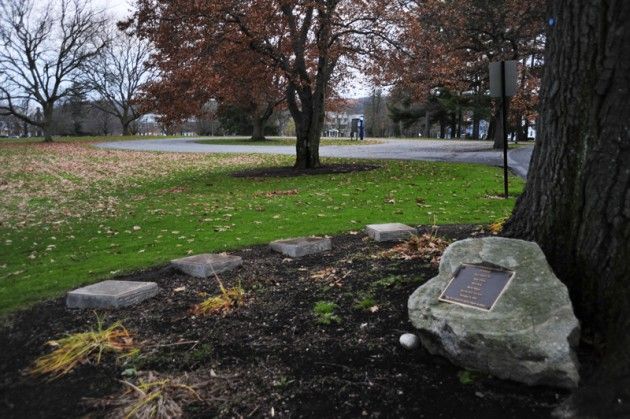The Crash That Changed Colgate
Most Colgate students have heard of the devastating car crash on campus near the mouth of Oak Drive. However, few are aware this Thursday, November 11, marks the ten-year anniversary of the crash and its four casualties. Among those killed that night was Katie Almeter, Colgate student and track runner, whose life was taken in the early morning of November 11, 2000.
Rob Koester, a Colgate junior at the time, stopped to pick up first-year Katie Almeter and two of her friends to give them a lift up the hill. At the time he stopped, the car already held three passengers. He started driving, and almost immediately crashed into one of the giant oak trees lining the street.
“It was a cold night, it was rainy, and the girls were walking. Then they got in the vehicle with [Koester] and about 150 feet later they were dead,” Jane Jones, Coordinator of Alcohol and Drug Education, said.
Koester sustained only minor injuries from the crash. Students Chris Rea and Elke Wagel also survived. Of the four students who died, Katie Almeter was the only one attending Colgate. Emily Collins and Rachel Nargiso were Katie’s high school friends from Norwich, who were visiting campus from Hobart and William Smith. The final casualty, Kevin King, was Koester’s best friend from home.
Koester was found to have had blood alcohol content of .17. He was charged with driving while intoxicated and four counts of second degree vehicular manslaughter.
“This accident was especially difficult because it was something that wasn’t expected,” Director of Counseling and Psychological Services Mark Thompson said.
Jones reiterated this sentiment.
“It’s so easy for people to think ‘it could never happen to me.’ But these were three girls, out for their last night before exams, and it was just bizarre.”
Jones, along with Thompson and a handful of others, is one of the few people left at Colgate who had a personal role in the aftermath of the accident.
“In the life of a college, a lot of people have already moved on,” Jones noticed. “You obviously don’t have student voices. And the Dean of the College staff has also changed a lot – so you don’t have this institutional voice and memory.”
But for Jones the memory is still vivid. “[After we found out about the accident] I was in Katie’s room just trying to be supportive of the students that were on her floor, when one of the girls’ phones rang. I don’t even remember her saying anything, but she handed her phone to me and it was Katie’s dad saying that he was at Colgate to pick up his daughter and couldn’t find her. I said let me look into it and I’ll call you back,” Jones said, trailing off.
This unspeakable grief was everywhere on campus.
“It’s one of those enormous community traumas that everybody feels,” Associate University Chaplain Mark Shiner said.
Director of Alumni Affairs Tim Mansfield was interviewing for his position during the aftermath of the accident. He was aware of the grief, and also the campus’s effort to figure out how to avoid future such accidents.
Since the students had fallen victim to an instance of drunk driving, “the culture of alcohol was on people’s minds,” Mansfield said. The accident prompted a task force to be put together to reexamine this culture.
“There’s nothing that will be able to take away the pain of Katie’s death,” Thompson said. “But there have been a couple of significant changes to the campus as a result of this tragedy. One is the cruiser, a second is our zero tolerance drunk driving policy.”
People who knew Katie and experienced the situation are wary of the tendency to reduce this tragedy to an example to learn from.
“One doesn’t want to reduce four vibrant lives into some message of warning,” Shiner said. “That message can be gleaned from what happened, but the message of Katie Almeter was that she was a delightful, talented, beloved person with good friends.”
The last memorial service for the tragedy was in 2007, when the photoengraved plaques were installed at the base of the Oak Drive tree that received the impact of the crash. Kathleen Kohl ’09 proposed and created the installation as a student here.
“There had been previous tributes for the deceased; however, none had quite addressed the enormity of the accident and how it then shaped the campus culture for later students. I wanted to create a memorial that would emphasize the youth and promise of the lives lost,” Kohl said.
This year’s memorial service, planned by Shiner, will take place on the night of Thursday, November 11 at 9:45 p.m. in Katie’s garden, a memorial located outside of West hall.
“Students would very much be welcome to attend; it would be entirely appropriate,” Shiner said. But since the time when students who knew Katie are no longer on campus, memorial services have been small groups consisting mostly of faculty and staff close to the tragedy.







